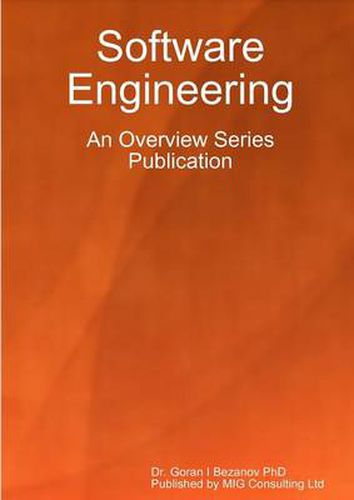Readings Newsletter
Become a Readings Member to make your shopping experience even easier.
Sign in or sign up for free!
You’re not far away from qualifying for FREE standard shipping within Australia
You’ve qualified for FREE standard shipping within Australia
The cart is loading…






This title is printed to order. This book may have been self-published. If so, we cannot guarantee the quality of the content. In the main most books will have gone through the editing process however some may not. We therefore suggest that you be aware of this before ordering this book. If in doubt check either the author or publisher’s details as we are unable to accept any returns unless they are faulty. Please contact us if you have any questions.
This textbook is intended to introduce the reader to the various aspects of a software engineering project. I describe the waterfall, exploratory programming, prototyping and other approaches to software engineering. This is followed by modelling to include a brief description of the Unified Modelling Language (UML). Requirements engineering is presented as the starting point of project management. This leads to design, which considers the programming paradigms as well as to the overall system architecture. I briefly cover fault tree analysis as well as Failure Mode and Effects Analysis (FMEA), Failure Modes, Effects and Criticality Analysis (FMECA) and Hazard and Operability (HAZOP). Testing helps to validate and verify the software product. I briefly cover white box and black box testing with emphasis on the procedures during testing. I cover quality assurance to include planning and control. Boehm’s COCOMO models provide a good starting point for estimating cost.
$9.00 standard shipping within Australia
FREE standard shipping within Australia for orders over $100.00
Express & International shipping calculated at checkout
This title is printed to order. This book may have been self-published. If so, we cannot guarantee the quality of the content. In the main most books will have gone through the editing process however some may not. We therefore suggest that you be aware of this before ordering this book. If in doubt check either the author or publisher’s details as we are unable to accept any returns unless they are faulty. Please contact us if you have any questions.
This textbook is intended to introduce the reader to the various aspects of a software engineering project. I describe the waterfall, exploratory programming, prototyping and other approaches to software engineering. This is followed by modelling to include a brief description of the Unified Modelling Language (UML). Requirements engineering is presented as the starting point of project management. This leads to design, which considers the programming paradigms as well as to the overall system architecture. I briefly cover fault tree analysis as well as Failure Mode and Effects Analysis (FMEA), Failure Modes, Effects and Criticality Analysis (FMECA) and Hazard and Operability (HAZOP). Testing helps to validate and verify the software product. I briefly cover white box and black box testing with emphasis on the procedures during testing. I cover quality assurance to include planning and control. Boehm’s COCOMO models provide a good starting point for estimating cost.